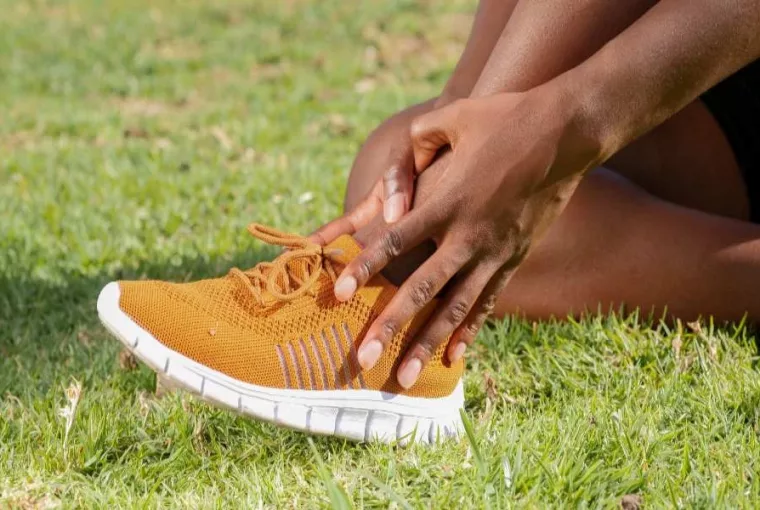Medial Tibial Stress Syndrome (MTSS) is one of the most commonly occurring injuries related to running. It’s also known as shin splints and causes extreme frustration and exhaustion among the injured runners.
Shin pain can be muscular, bony, neural, or vascular. This article discusses bony shin pain, what causes MTSS and what can be done. Continue reading below to learn all about it.
What Is Medial Tibial Stress Syndrome?
Medial Tibial Stress Syndrome constitutes a broad spectrum of injuries that affect the front of the shin. The conditions associated with MTSS will come gradually.
1. Periostitis
The calf muscle inserts into the shin bone that is the tibia, and this can become inflamed, painful, overloaded and aggravated. This appears as the tightness felt when starting an activity, but after a warm-up, it disappears. This pain can be felt at the front of the shin or inside it.
2. Bone stress reaction
If the early signs of pain are neglected, the condition can lead to stress on the bone. In this stage, the fractures have not yet developed, but there is swelling in the bone. This stress can be because of the muscle pulling on the bony part of the tibia or due to the force from the ground whenever the person takes a step.
Moreover, the bone on the outer side of the leg, known as the fibula and other areas of the tibia, can also come under stress. In this stage, the pain may disappear with activity, and in other cases, it might worsen with activity.
3. Stress fractures
If the condition is left untreated and progresses, the stress on the bone can cause small fractures to develop. These stress fractures are stable and will not lead to the complete breakage. The most commonly appear in the front and inside the tibia and cause localized deep pain. This pain worsens with activity and may even continue when resting.
How To Identify A Stress Fracture?
If you can easily push on your tibia and hop one leg without experiencing pain, it is very unlikely to have a stress fracture. Experiencing pain does not mean that you have fractures. It could also point towards other causes, including neural pain, compartment syndrome, referred pain, tendinopathy and infections or tumours. So if you experience any pain doing the test, it is advisable to get it checked out by a subiaco sports physio knowledgeable in sports.
What Are The Causes Of Shin Pain?
Knowing the causes that lead to shin pain will help you prevent pain and fractures. Here are some environmental and intrinsic factors that lead to shin pain.
Biomechanics
Biomechanics is the science of how living bodies move and how the bones, muscles, ligaments and tendons work together to move you. Biomechanics is how efficiently we move and run. If it is not optimal, it can lead to problems like shin pain. Biomechanical problems include hip drop, ankle range of motion, and foot pronation. Changes in movement patterns can cause stress on the shins and thus contribute to MTSS. This can be corrected with a proper plan of exercise.
Strength
The strength, as well as endurance of your calf, is a determining factor of MTSS. The calf muscle acts as a shock absorber, absorbing the force from the ground that travels up your body in every step. So if your muscles are not strong enough, the force will go to your bones, and they will come under a lot of stress.
Bodyweight
Increased body weight can put you at risk for various health problems and MTSS. A BMI of more than 30 can lead to shin pain. You should always consult with an experienced health professional before you go towards losing weight.
Ankle
Are you able to touch your toe and knee to the wall together without having to lift your heel? If the answer is no, then when you run, the stress will be put on other parts of your body and not your calf muscle. This can be improved with the help of professional treatments.
Type of foot
Having flat feet or increased pronation, you may be at risk for shin pain. This is because some of the muscles like the tibialis posterior, which support your feet, will be long as there is not enough arch support, so you may require specially customized footwear.
Footwear
The footwear you use can also cause shin pain. Since every foot is unique, it needs footwear according to the foot type and the activity it needs to be worn for. Appropriate cushioning and properly built shoes will allow good control.
The surface used for running
The surface you run on also matters when it comes to shin pain. Always running on hard surfaces can cause shin pain, so it is essential that you keep this in mind and switch the surfaces as often as possible.
Mistakes in training
Shin pain can also result from mistakes made during training. For instance, increasing the running load or training too hard too quickly. Obviously, you can increase the amount of your activity, but it needs to be done carefully and gradually. Otherwise, it will be detrimental to your body.
What Can Be Done About It?
The next question in your mind will be, “how can you improve your condition?” “What can be done?”
1. Keep your running load in check.
A sudden and high increase in running load is associated with an increased risk of MTSS. If your load is a lot for your bones and muscles or if your body is not given enough time to adjust and recover according to the load, there will be an increased risk of injuries and will become evident with shin pain. So keep your running load in check and gradually increase it so that your body has time to cope with it.
2. Try taping
Taping is a solution to prevent shin pain. It decreases the stress on your tissues. It is not a permanent solution to the problem, but it helps with your symptoms and gives you time to tend to the underlying causes.
3. Exercise
It is crucial that you exercise regularly and strengthen your muscles. Two main types of muscles you need to pay attention to include the calf muscle soleus and any other muscle in the lower limb, for example, the quads, hamstrings and glutes.
4. Use correct footwear
You should ensure you wear footwear that is according to your foot type. Apart from wearing the correct footwear, you also need to regularly replace your old shoes. Old shoes lose their flexibility and rigidity and thus the ability to support your feet. So it is important to replace shoes after running for 1000kms.
5. Technique of running
If your technique of running is incorrect, you may be at risk for MTSS. The improper running technique can lead to muscle tightness, muscle weakness, and ankle joint pain.
6. Consult a physio
Your physiotherapist will thoroughly inspect your muscles and bones, make a proper diagnosis and suggest effective treatment methods.




